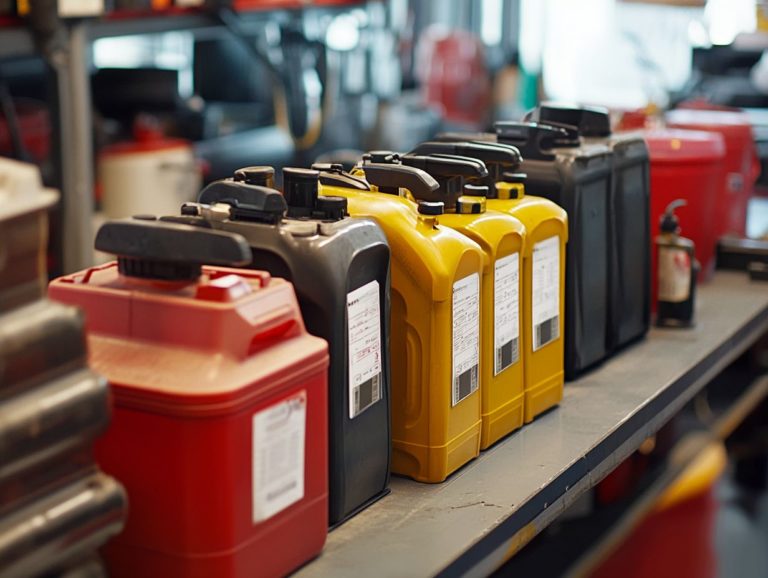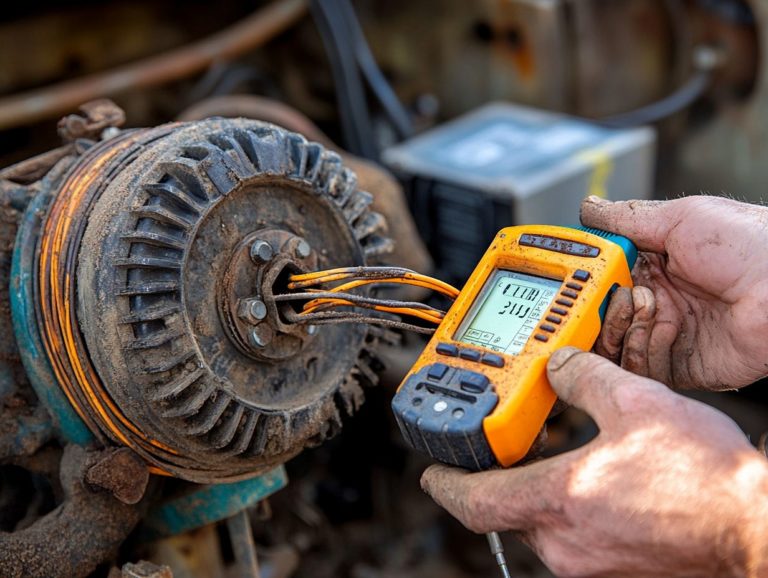Understanding Your Vehicle’s Warranty Coverage?
Navigating the realm of vehicle warranties can be quite the challenge, but grasping the nuances of your coverage is crucial for safeguarding your investment.
This article offers a comprehensive breakdown of what a vehicle warranty entails, including the various types and their specific coverages. It guides you through the claims process, points out common limitations, and weighs the pros and cons of extended warranties.
You’ll also discover tips for maximizing your warranty coverage, ensuring your vehicle remains in optimal condition. Dive in! Arm yourself with the knowledge you need to make smart decisions about your warranty!
Contents
Key Takeaways:

- Know the different types of vehicle warranties! Discover what they cover, including what s included and what s not.
- Be aware of the fine print and common limitations and restrictions in your vehicle’s warranty coverage.
- Maximize your warranty coverage by properly maintaining your vehicle. Consider the pros and cons of extended warranties!
What is a Vehicle Warranty?
A vehicle warranty represents a commitment from the manufacturer or a third-party provider to address specific repairs and parts issues that could emerge during your ownership. This ensures your peace of mind as a car owner.
This agreement can take the form of a manufacturer warranty, which generally covers repairs for a designated period, or an extended warranty that offers additional coverage beyond the original terms.
Understanding warranty terms helps you protect your vehicle. This knowledge can also boost your satisfaction as a consumer.
Definition and Types of Warranties
Vehicle warranties can be divided primarily into manufacturer warranties and extended warranties, each offering different levels of coverage. These include bumper-to-bumper warranties, which cover nearly every part of your vehicle, and powertrain warranties, which focus specifically on the engine and transmission. Knowing these differences is crucial for you as a car owner wanting to safeguard your investment.
Manufacturer warranties, typically offered by the vehicle s maker, come standard with new vehicles. They cover defects in materials and workmanship for a specified duration or mileage. In contrast, extended warranties can be purchased independently and may cover additional services or components that fall outside the manufacturer s scope.
Bumper-to-bumper coverage generally encompasses most parts of the vehicle, with only a few specific exclusions, while powertrain warranties focus on the key mechanics that keep your car moving. Knowing the implications of each type of warranty can significantly impact your repair costs and provide you with greater peace of mind.
What Does a Vehicle Warranty Cover?
Grasping the details of what a vehicle warranty covers is essential for you as a car owner, as it significantly influences your financial responsibilities during repairs and maintenance.
Warranty coverage includes essential repairs for components like electrical systems and drivetrains.
However, be mindful of exclusions that may exist, especially concerning wear-and-tear items or problems that stop your vehicle from working that are not explicitly outlined in your warranty agreement.
Inclusions and Exclusions
In your vehicle warranty, inclusions typically cover significant repairs to crucial parts like electrical systems, while exclusions highlight what s not covered potentially leading to surprising repair expenses.
For example, many warranties generally include coverage for essential components such as the engine, transmission, and major electrical systems, ensuring your vehicle remains operational without putting a strain on your finances. However, exclusions often encompass wear-and-tear items like tires, brake pads, and routine maintenance services, which can leave you open to unexpected out-of-pocket costs.
Knowing these differences is crucial. You might think your warranty covers more than it really does, leading to confusion when it comes time to make a claim. Therefore, it s essential to read the fine print carefully to grasp the specific inclusions and exclusions, ultimately shaping the overall effectiveness of your warranty.
Conclusion
Now that you understand your vehicle warranty, take steps to protect your investment today!
How to Make a Warranty Claim

Navigating the warranty claim process might seem challenging, yet understanding the right steps simplifies your interactions with warranty companies and dealership service departments.
Typically, you start by contacting the dealership or repair facility to present your warranty agreement. Then, submit a clear repair order that details the issues covered under your warranty protection.
With this knowledge, you can approach the process with confidence and clarity.
Step-by-Step Process
To file a warranty claim, first review your warranty agreement for coverage details. Next, create a repair order at an authorized dealership that outlines the issues with your vehicle.
Understanding the specifics of your warranty is important, as it defines your coverage and any limitations that may apply. Once you’re clear on the terms, head to an authorized dealership where a certified technician can assess the problem accurately.
Remember to document all conversations and keep copies of any repair orders or receipts. Maintaining clear records is key.
This level of transparency builds consumer trust and ensures you receive the necessary repairs efficiently. If you run into any hiccups during the process, don t hesitate to contact customer service for assistance they can offer guidance and clarification on your rights and the warranty claim process.
Understanding the Fine Print
Understanding the fine print is crucial for car owners like you. It often includes important warranty policies that outline what is covered, along with any common limitations or restrictions that could apply.
These nuances can significantly affect warranty costs and the overall value presented in the warranty manual.
Common Limitations and Restrictions
Common limitations in vehicle warranty policies often include not covering aftermarket parts, wear-and-tear items, and specific coverage options tied to the maintenance plan you choose.
These constraints can impact your expectations and experiences as a vehicle owner. You might assume that your warranty covers more situations than it actually does. For instance, if you add custom wheels to your car, it might void your warranty, resulting in costly repairs that wouldn’t have been necessary had you adhered to the original specifications.
Understanding the nuances of these policies like what qualifies as normal wear and tear can be frustrating. Therefore, it s crucial to thoroughly review your warranty documents to avoid any unpleasant surprises down the road.
Extended Warranty Options
Extended warranty options provide an extra layer of consumer protection that goes beyond the manufacturer s warranty. Often offered by various warranty companies and third-party providers, these warranties can significantly enhance your vehicle’s protection.
They provide you with peace of mind, ensuring you re covered for potential repair costs once the factory warranty has expired.
Pros and Cons of Extended Warranties

Extended warranties come with a mix of advantages and drawbacks. They offer additional coverage options but can also expose you to warranty scams that might tarnish your overall satisfaction as a consumer.
Navigating the intricacies of extended warranties can be overwhelming. While these warranties often ease the anxiety surrounding unexpected repair costs, it s vital to weigh whether the potential repair expenses truly justify the significant costs associated with purchasing these agreements.
Not all warranties offer the same level of protection. Conducting thorough research on various companies and their offerings can reveal terms or exclusions that might suit your needs better. Understanding the specific terms, limitations, and customer reviews is essential to ensure that your investment genuinely enhances your peace of mind, rather than leading to frustration and financial setbacks.
Don’t wait! Review your warranty today to avoid surprises tomorrow!
In summary, knowing your warranty inside and out can save you time, money, and stress. Take charge of your coverage, and enjoy peace of mind on the road!
Maximizing Your Warranty Coverage
Maximizing your warranty coverage requires a thorough understanding of the terms outlined in your warranty agreement and a commitment to proper vehicle maintenance practices. This enhances your warranty protection and ensures a positive experience when dealing with dealership services.
Being proactive in these areas can significantly contribute to both the longevity of your vehicle and your satisfaction as a customer.
Tips for Maintaining Your Vehicle
Proper vehicle maintenance is essential for maximizing your warranty protection and aligning with the guidelines in the warranty manual. This diligence fosters a positive relationship with your dealership’s service department and serves your interests well.
Regularly checking fluid levels, tire pressures, and brake conditions can reduce potential issues. Staying on top of routine services, like oil changes and filter replacements, enhances your vehicle s performance and prevents costly repairs.
It s crucial to follow the timelines and procedures detailed in the warranty documentation. Following the guidelines helps protect your warranty. Proactively engaging with your maintenance schedule will lead to a safer and more reliable driving experience.
Frequently Asked Questions
-
What is covered under my vehicle’s warranty?
-
Your vehicle’s warranty typically covers defects in materials or workmanship for a certain period. This can include repairs or replacements for parts like the engine, transmission, and electrical components.
-
Is routine maintenance covered under my warranty?
-
Routine maintenance, like oil changes and tire rotations, is usually not covered under your vehicle’s warranty. It s important to follow the recommended maintenance schedule to keep your vehicle in good condition.
-
How long does my warranty coverage last?
-
The length of your vehicle’s warranty coverage can vary, but it typically ranges from 3 to 5 years or a certain number of miles, whichever comes first. Check your warranty documentation for specific details.
-
What is a powertrain warranty?
-
A powertrain warranty covers major components like the engine, transmission, and drivetrain. This type of warranty usually lasts longer than a basic warranty and may have different coverage terms.
-
What voids my vehicle’s warranty?
-
Modifications or changes to your vehicle not approved by the manufacturer can void your warranty. This includes adding aftermarket parts or neglecting routine maintenance. Follow the guidelines in your warranty documentation to avoid voiding your coverage.
-
Do I need to purchase an extended warranty for my vehicle?
-
It s not necessary to buy an extended warranty since your vehicle comes with a manufacturer’s warranty. However, if you plan on keeping your vehicle for a long time, an extended warranty may provide additional coverage and peace of mind.
Don’t wait check your warranty documentation today!







